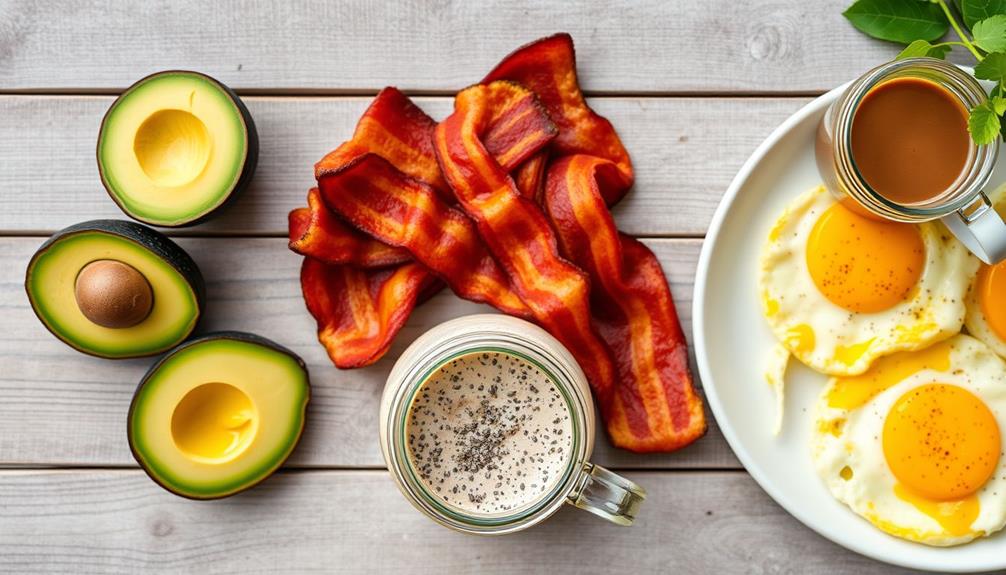To keep your meal prep exciting and avoid boredom, regularly introduce new ingredients, flavors, and cooking techniques. Incorporate different proteins like fish or tofu, rotate grains such as quinoa or brown rice, and experiment with varied spices and herbs. Try grilling, roasting, or steaming to add texture and depth. Planning a diverse weekly menu with seasonal or sale items keeps things fresh. Keep exploring new recipes and flavor pairings—continuing further reveals even more ideas to spice up your meals.
Key Takeaways
- Incorporate diverse proteins, grains, and vegetables to keep meals interesting and nutritionally balanced.
- Use different cooking methods like grilling, steaming, and roasting to introduce new textures and flavors.
- Add fresh herbs, spices, and citrus to enhance flavors and create culinary variety.
- Plan weekly menus that rotate ingredients and cuisines for ongoing excitement.
- Experiment with presentation and texture techniques, such as searing or using seasonal ingredients, to boost visual appeal and sensory interest.

Meal prep can save you time and help you eat healthier, but it’s easy to get stuck in a rut and lose interest in your meals. When you stick to the same recipes week after week, your enthusiasm wanes, and mealtime becomes a chore rather than a pleasure. To keep your routine fresh and exciting, focusing on meal variety is key. Instead of preparing the same dishes repeatedly, experiment with different ingredients, cuisines, and cooking techniques. Incorporate a mix of proteins, grains, and vegetables to create diverse meals that prevent boredom and keep your palate engaged. Rotating between chicken, fish, tofu, and legumes ensures you get a broad spectrum of nutrients while maintaining variety. Switching up your grains—try quinoa, brown rice, or barley—adds new textures and flavors, making each meal feel different.
Variety in proteins, grains, and vegetables keeps meal prep exciting and nutritious.
Flavor enhancement plays a vital role in maintaining interest in your meal prep. Even simple changes like adding fresh herbs, spices, or zesty citrus can transform a dish from dull to delightful. Use spice blends such as cumin, paprika, or curry to introduce rich, layered flavors that elevate your dishes without extra effort. Marinades are another great way to boost flavor; soaking your proteins in a mixture of soy sauce, garlic, ginger, or citrus before cooking creates depth and complexity. Don’t forget about condiments and toppings—salsa, chutney, or a dollop of yogurt can add a burst of flavor that makes a simple meal feel special. Additionally, incorporating flavor layering techniques can make even straightforward dishes more complex and satisfying. Incorporating cooking techniques like searing or slow-cooking can also add variety in texture and presentation. Exploring regional specialties, such as incorporating Italian Focaccia as a side or appetizer, can also bring new ideas and flavors to your meal prep routine.
Furthermore, changing your cooking methods can give your meals a new dimension. Grilling, roasting, steaming, or stir-frying each impart different textures and tastes. For instance, roasting vegetables caramelizes their natural sugars, adding sweetness and depth, while steaming preserves their crispness and freshness. Incorporating different cooking styles keeps your meal prep interesting and prevents the monotony that comes with doing everything the same way. Incorporating gourmet techniques such as sous-vide or smoking can elevate your dishes and introduce new sensory experiences. Additionally, experimenting with seasonal ingredients ensures you incorporate fresh, vibrant flavors while supporting local produce.
Finally, planning ahead by creating a flexible weekly menu allows you to mix and match ingredients based on what’s in season or on sale. This approach not only saves money but also introduces you to new flavors and combinations regularly. Keep a list of new recipes or flavor pairings you want to try, and rotate them into your routine. This way, meal prep remains engaging rather than a tedious chore, and you look forward to each week’s culinary adventure. With a little creativity and intentional variety, you can enjoy healthy, flavorful meals that never become boring.
Frequently Asked Questions
How Can I Incorporate Seasonal Ingredients Into My Meal Prep?
To incorporate seasonal ingredients into your meal prep, focus on seasonal sourcing to find fresh, local produce that enhances flavor naturally. You can add these ingredients to your recipes for flavor enhancement and variety, keeping meals exciting. Try roasting root vegetables in winter or adding fresh berries in summer. This approach not only boosts taste but also supports local farmers and makes your meals more nutritious and vibrant throughout the year.
What Are Quick Ways to Change up My Meal Presentation?
Imagine giving your meals a fresh glow-up with simple plating techniques. You can start by rearranging ingredients for visual interest or adding colorful garnishes like herbs, citrus slices, or vibrant sauces. These quick tweaks make your dishes pop without extra effort. Play with height, contrast, and symmetry to elevate your presentation instantly. These small touches turn everyday meals into eye-catching plates, making your dining experience more enjoyable and visually exciting.
How Do I Plan for Meal Prep When Dining Out?
When planning for meal prep while dining out, you should start with grocery shopping to pick versatile ingredients you can use for home-cooked meals and leftovers. Budget planning helps you allocate funds wisely, ensuring you can enjoy dining out without overspending. Keep a list of favorite restaurant dishes to recreate at home, adding variety to your weekly menu. This approach keeps your meals exciting and cost-effective.
Can I Meal Prep for Specific Dietary Restrictions?
Yes, you can definitely meal prep for specific dietary restrictions. If you’re gluten-free or vegan, choose ingredients that fit your needs, like fresh vegetables, gluten-free grains, and plant-based proteins. Plan your meals ahead, focusing on safe options, and batch cook to save time. By customizing your prep, you guarantee your meals stay nutritious, satisfying, and aligned with your dietary restrictions, making weekly meal planning easier and more enjoyable.
How Often Should I Rotate My Meal Prep Recipes?
You should rotate your meal prep recipes every one to two weeks to prevent recipe repetition from becoming boring. This allows you to enjoy culinary experimentation and keeps your meals fresh and exciting. Changing up your recipes regularly helps you discover new flavors and techniques, so you’re less likely to feel stuck in a rut. Stay flexible, and don’t be afraid to try new dishes to keep your weekly menu lively.
Conclusion
Just as Da Vinci’s masterpieces captivate with their innovation, your weekly menu can remain fresh and exciting by embracing variety. Don’t let routine stifle your culinary creativity; instead, explore new flavors and textures. Remember, the joy of meal prep lies in discovery—each new dish adds a brushstroke to your own vibrant canvas. Keep experimenting, and your meals will always be a masterpiece worth savoring.









